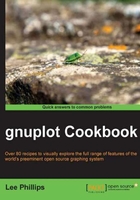
Why this book?
Because of gnuplot's many years of deployment and sophisticated community of expert users, help is usually easy to find in some form. If you are trying to solve a tricky plotting problem, there is a reasonable chance that someone online has either figured it out or is willing to share some ideas about how it might be done.
However, there is little available in the form of a convenient reference with the structure of a cookbook, where you can look for an example of the type of plot you are trying to create and see instantly how it can be done, with a runnable example.
This book is designed to be that combination of reference and tutorial. It goes beyond plotting recipes, however, and will show you how to incorporate your graphs into documents, how to create interactivity, how to program and automate gnuplot, and more. Each example is in the form of a recipe with immediately runnable code in electronic form, and with clear explanations that will show you how to modify the recipe to solve your particular problem. Each recipe is illustrated with the plot created by the procedure, so you can use the book as a visual index that will allow you to quickly find the solution you are looking for.
One of our goals is to show you the major new features in the latest release version of gnuplot, version 4.4.3. Even experienced users of gnuplot are likely to find these sections useful, as we include an illustrative recipe for each new feature; these are specially marked so that features making their first appearance in gnuplot 4.4 can be located quickly. These new features include the use of Unicode characters, transparency, new graph positioning commands, plotting objects, internationalization, circle plots, interactive HTML5 canvas plotting, iteration in scripts, lua/tikz/LaTeX integration, cairo and SVG terminal drivers, and volatile data.